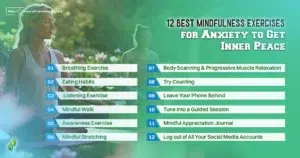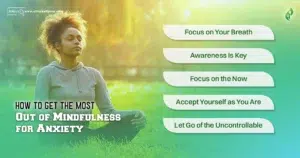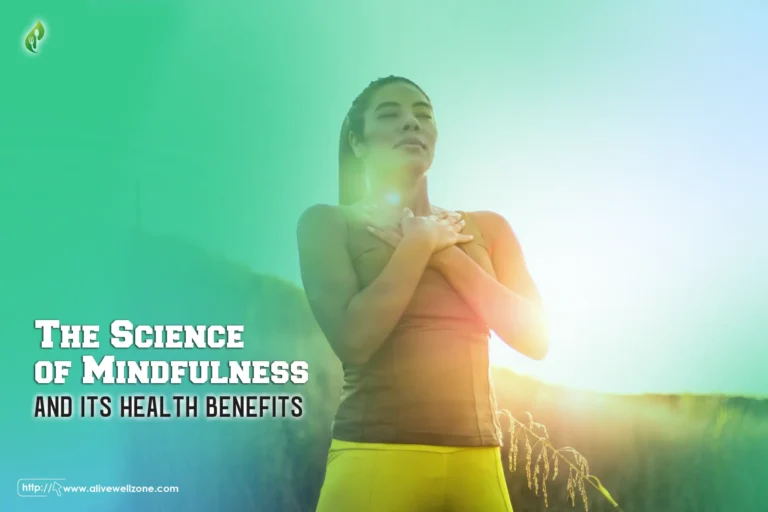
Do you feel like anxiety is always breathing down your neck, making it hard to find calm within yourself? Are you trapped in a cycle of endless worries and physical discomfort that wears you out?
Good news! Mindfulness exercises for anxiety are a strong way to break out of this draining cycle. You can take back control of your emotions by learning to focus on the present and using mindfulness-based coping methods.
So, we’ve put together a detailed guide on various anxiety-relieving exercises. You’ll know the benefits of using them, and how you can get more results from our exercises. So, prepare to find your peace and enjoy the beauty of now.
What Does Mindfulness Mean?
Mindfulness means fully engaging with every moment of your life, and accepting each situation as it comes. It’s about focusing on the now like what you’re doing, what’s happening around you, and how you feel.
Plus, it involves paying attention to your current experience, who you are with, and how you feel, without getting lost in them or judging them. Unlike specific mental health therapies like cognitive behavior therapy (CBT), mindfulness doesn’t follow a rigid structure or set of techniques.
Whenever your mind drifts, you gently return your focus to the now and observe your thoughts and feelings without attaching to them.
How Does Mindfulness Work?
Mindfulness improves mental well-being by changing how you deal with stress. Often, stress and anxiety are less about actual events and more about how you perceive them. In fact, getting too wrapped up in negative thoughts can make them seem like your reality.
Most of our stress is rooted in past events or future worries, not in what’s currently happening. Thus, practicing mindfulness trains your brain to stay in the present, helping you step back from your thoughts about a situation and just exist in the moment.
This process helps clear your mind, providing a break from the constant buzz of thoughts.
What are the Benefits of Mindfulness?
Mindfulness might seem like just another trend, but there’s a solid science of mindfulness and its health benefits with evidence. It’s proven to have significant mental health benefits.
People who meditate regularly have more gray matter density in parts of the brain that control attention, memory, and emotions. For instance, participants in a 6-week mindfulness course reduced stress levels, according to a 2021 study.
But the benefits of mindfulness aren’t limited to mental health. It also has physical advantages. Engaging in mindfulness activates the part of your nervous system that calms the body, lowering high blood pressure and fast heartbeat.
Interestingly, a 2022 study showed that mindfulness could be as effective as escitalopram, a commonly prescribed depression and anxiety medication. While it’s not a cure-all for mental health issues, mindfulness is increasingly recognized as a viable treatment method.
Mindfulness can also offer relief for insomnia and other sleep issues. Because insomnia is often linked to anxiety and depression, mindfulness makes it easier to fall asleep and stay asleep.
12 Best Mindfulness Exercises for Anxiety to Get Inner Peace

Without raising your anxiety anymore, here are some top yet quick mindfulness exercises for anxiety. Check them out and try to implement them in your daily life.
1. Breathing Exercise
A simple way to bring mindfulness into your day is through mindful breathing exercises. This method is all about focusing on your breath to calm your mind.
- Start by picking a meditation app where you can set a timer, and try beginning with just five minutes.
- Choose a quiet spot and sit comfortably with your feet on the ground.
- Close your eyes and pay attention to your breathing—inhale and exhale slowly.
- If you find your thoughts drifting, just notice that and gently return your focus to your breathing.
A helpful technique is cyclic sighing, where you breathe in for four seconds, hold your breath for six, and then exhale slowly for seven seconds.
2. Eating Habits
Think about how often you eat without really paying attention, maybe while watching TV or browsing on your phone. Mindful eating is about being fully present and savoring each bite of your meal. It helps you listen to your body’s hunger signals and improves how you view food.
Thus, make an effort to eat without distractions. Notice the taste, texture, and aroma of your food. Chew each bite thoroughly and focus on how your body feels as you eat.
3. Listening Exercise
When it comes to mindfulness exercises for anxiety, you can’t avoid active listening. Well, it means giving your full attention during a conversation. When someone is speaking, listen closely without making judgments or interrupting. Pay attention to their body language, how they say things and their expressions.
This approach not only helps you understand the person better but also strengthens your connection with them by showing you’re truly engaged.
4. Mindful Walk
Walking can be a great way to ease anxiety, especially if you do it with mindfulness. For an indoor mindful walk, take off your shoes and focus on the sensation of your feet touching the ground. Notice the texture and temperature underfoot.
Also, feel the movement in your body and try walking slowly for a few minutes, observing how it feels.
When walking outside, immerse yourself in your surroundings. Observe what you see, hear, smell, and touch. Feel the air on your skin and the sun’s warmth. You can acknowledge anxious thoughts, then gently bring your attention back to what you’re experiencing now.
5. Awareness Exercise
Practicing mindful awareness exercise means paying close attention to what you sense and experience at any moment. This method is particularly effective in lessening feelings of anxiety and overthinking, improving your concentration. To start, simply observe your environment.
Look around to see what’s nearby. Listen for different sounds. Notice any physical sensations you’re feeling. Aim to use all your senses to capture the details around you.
As you breathe deeply, let each breath guide your senses to explore how your body feels in space.
6. Mindful Stretching
Engaging in mindful stretching can help bridge the connection between your mind and body, increasing flexibility and easing tension. Choose a tranquil spot and concentrate on your breathing to begin.
On top of that, you can learn to do passive stretching. With each stretch, stay mindful of the present, tuning into the sensations across your body. Be aware of any discomfort and gently address it. After finishing, take a moment to feel the effects on your body and muscles.
For those with physical limitations, you can still benefit from this activity by performing a body scan meditation while seated. And if you’re more physically active, consider incorporating these mindfulness exercises for anxiety into your regular workouts.
7. Body Scanning & Progressive Muscle Relaxation
A recent study in 2021 showed that animals who tried body scanning through virtual sessions felt less stressed and anxious after just one go. Progressive muscle relaxation (PMR) involves tensing up different muscle groups gently and then relaxing them to feel the release.
Another study noted significant anxiety relief in patients who practiced PMR regularly for 12 weeks. If you’re waiting for the light to change, standing in a queue, or sitting down, you can do this exercise.
- Begin with your feet, paying attention to any sensations they might have. (Are they tight or comfortable?)
- Try moving your toes, rotating your ankles, and stretching your feet to ease any tightness. Notice the relief as your foot muscles relax.
- Continue this process with your calves, paying attention to how they feel as you tense and then release them.
- Work your way up through your body to your head, focusing on relaxing each muscle group one by one.
If you find your thoughts drifting, gently bring your focus back to the mental health awareness exercise you’re doing. It’s one of the easiest mindfulness exercises for anxiety that can significantly reduce anxiety and help you feel more relaxed.
8. Try Counting
The 5-4-3-2-1 method is one of the simplest activities for anxiety that uses your senses to bring you into the current moment. Here’s how it goes —
- See: Look for five items around you.
- Hear: Focus on three different sounds you can hear.
- Touch: Feel four objects or surfaces.
- Taste: Think about one taste.
- Smell: Identify two smells.
Take your time with each sense, really noticing the small details. Make this exercise a regular part of your day or just when you need a moment to center yourself.
9. Leave Your Phone Behind
Consider whether you need your phone every time you move to a different room, use the bathroom, or have a meal. Try leaving your phone behind sometimes. Before you eat, just sit and breathe for a moment.
Give yourself a break and focus on your needs when in the bathroom. Your phone will be right where you left it afterward.
10. Tune into a Guided Session
For those new to mindfulness or even for those who have been practicing for a while, calming your mind can be tough. Listening to a guided mindfulness session can help guide your thoughts in a peaceful direction.
Many apps provide these free mindfulness exercises for anxiety, and we’ve listed six top choices on our resource page for you to explore.
11. Mindful Appreciation Journal
Keeping a journal where you note down what you’re grateful for each day can boost your mood and encourage a more positive outlook on life. Start with anything that makes you thankful, using whatever method suits you best—be it a bullet journal, a digital note, or just a simple piece of paper.
This habit not only serves as a daily reminder of the good in your life but can also be a focus point during your quick mindfulness exercises for anxiety.
12. Log out of All Your Social Media Accounts
This next step might be challenging, but it’s worth it. Social media can often increase anxiety and distract you from your tasks. You might not realize how often you’re scrolling through your feeds.
Try logging out to make accessing these platforms less automatic. If you decide to log back in, do it with a purpose or time limit in mind, to avoid losing track of time or feeling guilty for procrastinating.
Consider deleting some accounts if you’re on multiple platforms. Research has linked the use of several social media sites to heightened anxiety in young adults. Cutting down could be a big step toward caring for you and reducing your stress.

Is Mindfulness Effective for Anxiety?
Yes, mindfulness can significantly aid in managing anxiety symptoms.
A study from 2019 looked into how an 8-week program called mindfulness-based stress reduction (MBSR), intended for cancer patients, impacted their health. The findings suggest that MBSR can slightly lessen symptoms of anxiety and depression while also improving sleep quality.
In the same study, symptoms were reduced irrespective of whether the program was followed for six months or two years.
Moreover, a 2021 study focusing on working adults aged 60 to 65 showed that MBSR could lead to noticeable improvements in —
- Stress perception
- Anxiety
- Emotional distress
- Depression
- Overall life satisfaction
You can better understand how your body responds to stress when you practice mindfulness. With regular mindfulness practice, you can learn to control and lessen your anxiety symptoms over time.
How to Get the Most Out of Mindfulness for Anxiety

Mindfulness, with its focus on the present rather than on past or future concerns, offers a simple approach to calming your mind. Although it doesn’t have complex rules, practicing certain elements can help you face life’s challenges more serenely and lower your anxiety.
Here are some strategies to improve your mindfulness exercises for anxiety —
Focus on Your Breath
Taking slow, deep breaths and noticing the sensation and sound of your breath as it moves in and out can ground you in the present.
When anxiety tries to capture your attention, shifting your focus to your breathing can bring you back to the current moment. By easing the fight-or-flight response, this practice also relaxes your body and encourages rest.
Awareness Is Key
Trying to dodge feelings of worry and fear is a common response to anxiety. However, this habit of avoidance can actually stop you from experiencing life to its fullest. Mindfulness teaches you to be fully aware of yourself and your environment exactly as they are right now.
Improving your awareness has been linked to reduced stress and anxiety, better mood, and overall enhanced well-being.
Focus on the Now
Mindfulness aims to shift your focus from anxious thoughts and feelings. Instead of avoiding these thoughts, you recognize them and then choose to focus on something real and immediate: the present moment.
Anxiety often triggers negative automatic thoughts about yourself, others, and various situations in your life. Using mindfulness can help you escape the relentless worries and fears associated with anxiety by concentrating on the present.
Accept Yourself as You Are
Mindfulness teaches us to accept and not judge our current experiences. Instead of evaluating how you feel about what’s happening, you simply acknowledge it for what it is.
It doesn’t mean you have to accept situations that are harmful or wrong. In mindfulness, acceptance and non-judgment mean noticing your experiences without getting tangled in thoughts about them. This way, you stay calm and choose how to react wisely.
Let Go of the Uncontrollable
Mindfulness helps us notice ourselves and our surroundings without making judgments, allowing us to calmly let go of things beyond our control. By focusing on the present, mindfulness practices encourage us to move away from anxiety’s grip and peacefully embrace the moment as it is.
Why Some People Find Mindfulness Practice Difficult
Mindfulness, while beneficial for better sleep, stress relief, and overall health, isn’t always easy for everyone. A few reasons stand out for why people might struggle with it.
First, dealing with uncertainty can be tough. Accepting that not everything is black and white is a big part of mindfulness that some find challenging.
Beginners often hope for quick fixes and feel let down when immediate improvements in their mood or life perspective don’t happen. Mindfulness requires regular practice and commitment to truly see its effects.
Most people tend to wish for a different future instead of accepting what is now, especially when it causes them discomfort, according to research. Mindfulness asks for patience, perseverance, and bravery to face what’s troubling you, which can be daunting.

Then there’s the issue of procrastination—waiting for the perfect time to start practicing mindfulness, which never comes. The best way to experience mindfulness’s benefits is to incorporate it into your daily life, even just for a short while each day.
Conclusion
With the pace of life today, it might seem hard to find peace. But, mindfulness exercises for anxiety offer a ray of hope. It’s more than just quiet time; it’s about being fully in the moment, aware, and accepting yourself without criticism.
Simple acts like breathing deeply, enjoying a peaceful walk, or taking a break from social media can greatly reduce your anxiety. We invite you to try out these mindfulness practices mentioned. Adding them to your daily life can help you find calm and balance.
Overall, mindfulness has the power to change our lives for the better, one moment at a time, and we encourage you to discover its benefits.
FAQs
Can I practice mindfulness on my own?
You can definitely start practicing mindfulness by yourself, and it’s quite beneficial. Look for a quiet and comfortable place where you can spend a few minutes each day on mindfulness exercises. Pay attention to your thoughts and feelings without judging them, or simply focus on your breathing.
What mindfulness technique is often used to reduce stress and anxiety?
A common mindfulness technique to ease stress and anxiety is deep breathing. When you breathe deeply and slowly, you signal your body to relax, helping calm your mind.
Can you overdo mindfulness?
Yes, you can overdo mindfulness. When you pay too much attention to your thoughts and feelings, you might experience depression, anxiety, feeling out of touch, substance abuse issues, and pain.
What is the 3 3 3 rule in mindfulness?
The 3-3-3 rule is an easy way to deal with anxiety as it arises. When feeling anxious, name 3 things you can see, 3 sounds you can hear, and move 3 parts of your body. This technique helps shift your focus away from what’s stressing you and keeps you grounded in the moment.



